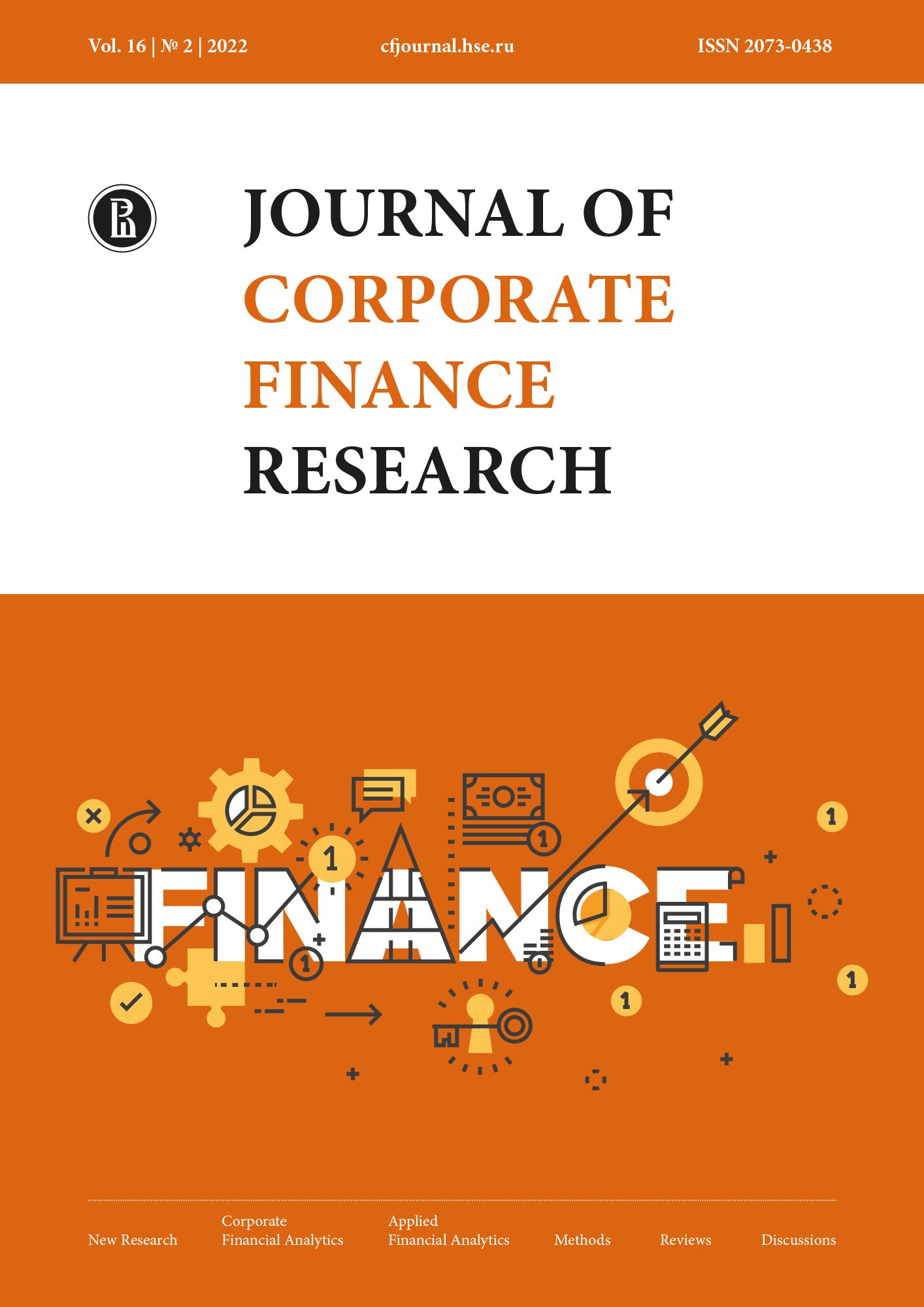Как внешние шоки влияют на экономическую эффективность компаний с прямыми иностранными инвестициями?
Аннотация
В статье рассматривается эффективность экспортной и импортной деятельности отечественных компаний с прямыми иностранными инвестициями в условиях внешних шоков. Актуальность темы обусловлена неоднозначной оценкой влияния побочных эффектов ПИИ на отечественные компании и экономической неопределенностью после введенных санкций и вспышки пандемии COVID-19. Эмпирическая база содержит около 170 000 наблюдений по 18 799 действующим компаниям с долей иностранного капитала не менее 10% за период с 2012 по 2020 г., полученных из базы данных Ruslana - Bureau Van Dijk. В целях исследования компании сгруппированы с учетом отраслевой специфики и участия в международной торговле. Методология исследования включает оценку эффективности с помощью метода оболочки данных DEA с учетом спилловер-эффектов от прямых иностранных инвестиций и панельно-регрессионного анализа. Результаты исследования подтверждают, что фирмы, осуществляющие торговлю в обоих направлениях, наиболее эффективны. Следом идут компании, ориентированные только на экспорт или импорт. Наименее эффективны компании, не участвующие в международной торговле (гипотеза 1). Отрасли, которые выигрывают от притока прямых иностранных инвестиций, включают более капиталоемкие секторы (гипотеза 2). Внешние шоки оказывают негативное влияние на эффективность компаний с прямыми иностранными инвестициями (гипотеза 3). Это понимание имеет важные последствия для экономического роста в долгосрочной перспективе и восстановления российской экономики в условиях нынешних внешних шоков.
Скачивания
Литература
Customs statistics of foreign trade documents. Federal Customs Service of Russia. URL: http://stat.customs.gov.ru/documents (accessed on 01.04.2022). (In Russ.).
Fedorova E.A., Nikolaev A.E., Shirokova Yu.S., Fedorov F.Yu. Export and import activities of Russian companies with FDI in the context of sanctions. Finansovyi zhurnal = Financial Journal. 2019;(3):75-90. (In Russ.). DOI: 10.31107/2075-1990-2019-3-75-90 DOI: https://doi.org/10.31107/2075-1990-2019-3-75-90
External Sector statistics. Bank of Russia. URL: https://cbr.ru/statistics/macro_itm/svs/ (accessed on 01.04.2022). (In Russ.).
European investment attractiveness survey 2020: Russia. Moscow: Ernst & Young; 2021. 20 p. URL: https://assets.ey.com/content/dam/ey-sites/ey-com/ru_ru/news/2021/06/european-attractiveness-survey-2021-russia-ver-2.pdf (accessed on 01.04.2022). (In Russ.).
Sharma C., Mishra R.K. International trade and performance of firms: Unraveling export, import and productivity puzzle. The Quarterly Review of Economics and Finance. 2015;(57):61-74. https://doi.org/10.1016/j.qref.2015.02.001 DOI: https://doi.org/10.1016/j.qref.2015.02.001
Kasahara H., Lapham B. Productivity and the decision to import and export: Theory and evidence. Journal of International Economics. 2013;89(2):297-316. https://doi.org/10.1016/j.jinteco.2012.08.005 DOI: https://doi.org/10.1016/j.jinteco.2012.08.005
Muûls M., Pisu M. Imports and exports at the level of the firm: Evidence from Belgium. The World Economy. 2009;32(5):692–734. https://dx.doi.org/10.1111/j.1467-9701.2009.01172.x DOI: https://doi.org/10.1111/j.1467-9701.2009.01172.x
Ran J., Voon J.P., Li G. How does FDI affect China? Evidence from industries and provinces. Journal of Comparative Economics. 2007;35(4):774-799. https://doi.org/10.1016/j.jce.2007.05.001 DOI: https://doi.org/10.1016/j.jce.2007.05.001
Kuznetsov D.E. Analysis of relation between capital intensive sectors and direct foreign investments. Ekonomicheskoe razvitie Rossii = Russian Economic Developments. 2019;26(11):23-30. (In Russ.).
Antràs P., Yeaple S.R. Multinational firms and the structure of international trade. In: Gopinath G., Helpman E., Rogoff K., eds. Handbook of international economics. Amsterdam: Elsevier B.V.; 2014:4:55-130. https://doi.org/10.1016/B978-0-444-54314-1.00002-1 DOI: https://doi.org/10.1016/B978-0-444-54314-1.00002-1
Zapadnyuk E.A. The impact of global financial shocks on the world economy. Belarus' i mirovye ekonomicheskie processy : sbornik nauchnyh statej= Belarus and world economic processes : collection of scientific articles. Minsk; 2015;(12):189-197. URL: https://elib.bsu.by/bitstream/123456789/148928/1/189-197.pdf (In Russ.).
Wong Z., Chen A., Peng D., Kong Q. Does technology-seeking OFDI improve the productivity of Chinese firms under the COVID-19 pandemic? Global Finance Journal. 2022;51:100675. https://doi.org/10.1016/j.gfj.2021.100675 DOI: https://doi.org/10.1016/j.gfj.2021.100675
Zarbi S., Shin S.-H., Shin Y.-J. An analysis by window DEA on the influence of international sanction to the efficiency of Iranian container ports. The Asian Journal of Shipping and Logistics. 2019;35(4):163-171. https://doi.org/10.1016/j.ajsl.2019.12.003 DOI: https://doi.org/10.1016/j.ajsl.2019.12.003
Vujanović N., Stojčić N., Hashi I. FDI spillovers and firm productivity during crisis: Empirical evidence from transition economies. Economic Systems. 2021;45(2):100865. https://doi.org/10.1016/j.ecosys.2021.100865 DOI: https://doi.org/10.1016/j.ecosys.2021.100865
Bykova A., Jardon C.M. Lean against the wind: The moderation effect of foreign investments during the economic recession in Russia. Journal of Economics and Business. 2017;93:1-14. https://doi.org/10.1016/j.jeconbus.2017.07.001 DOI: https://doi.org/10.1016/j.jeconbus.2017.07.001
Fedorova E.A., Nikolaev A.E., Rashchupkina A.A., Fedorov F.Yu. Evaluation of the effectiveness of foreign direct investment impact on the activities of domestic companies during the sanctions period: Industry aspect. Vestnik Moskovskogo universiteta. Seriya 6: Ekonomika = Moscow University Economic Bulletin. 2020;(5):158-181. (In Russ.). DOI: https://doi.org/10.38050/01300105202058
Charnes A., Cooper W.W., Rhodes E. Measuring the efficiency of decision making units. European Journal of Operational Research;1978:(2):429–444. https://doi.org/10.1016/0377-2217 (78)90138-8 DOI: https://doi.org/10.1016/0377-2217(78)90138-8
Mirmozaffari M., Yazdani R., Shadkam E. et al. An integrated artificial intelligence model for efficiency assessment in pharmaceutical companies during the COVID-19 pandemic. Sustainable Operations and Computers. 2022;3:156-167. https://doi.org/10.1016/j.susoc.2022.01.003 DOI: https://doi.org/10.1016/j.susoc.2022.01.003
Rath B.N. Productivity growth and efficiency change: Comparing manufacturing- and service-based firms in India. Economic Modelling. 2018;70:447-457. https://doi.org/10.1016/j.econmod.2017.08.024 DOI: https://doi.org/10.1016/j.econmod.2017.08.024
Fedorova E.A., Tkachenko A.A., Fedorov F. Yu, Mazalov E.S. Evaluation of the technical efficiency of companies of the military-industrial complex. Korporativnye Finansy = Journal of Corporate Research.2015;4(36):140-149. https://doi.org/10.17323/j.jcfr.2073-0438.9.4.2015.138-148 DOI: https://doi.org/10.17323/j.jcfr.2073-0438.9.4.2015.138-148
Lin P., Liu Z., Zhang Y. Do Chinese domestic firms benefit from FDI inflow? Evidence of horizontal and vertical spillovers. China Economic Review. 2009;20(4):677-691. https://doi.org/10.1016/j.chieco.2009.05.010 DOI: https://doi.org/10.1016/j.chieco.2009.05.010
Dranko O.I. The capital requirements of the activity types of the Russian economy. Audit i finansovyi analiz = Audit and Financial Analysis. 2015;(3):67-70. URL: https://www.auditfin.com/fin/2015/3/fin_2015_31_rus_03_02.pdf (In Russ.).
Copyright (c) 2022 Национальный исследовательский университет «Высшая школа экономики»

Это произведение доступно по лицензии Creative Commons «Attribution-NonCommercial-NoDerivatives» («Атрибуция — Некоммерческое использование — Без производных произведений») 4.0 Всемирная.

